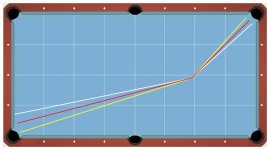A shot all of us face at one point or another is the do or die SPOT SHOT. How do you shoot yours when faced with it? What method of aiming do you use to home in to the exact angle and contact between the CB and OB? Is your stroke strong enough to do it over and over without missing even when the CB is moved around the table to different areas? Is it always a half ball aim and hit? If the CB is moved, what changes are made to make it?
Here's a way to do it with the same aim line, over and over from different parts of the table:
https://www.youtube.com/watch?v=IdTBDO_6au4&list=UUW8lTFYIYGN2AjHKN23M-RQ&index=22&t=0s
Please do make a video showing how you do it with explanation.
Cue ball close to the second diamond on the rail and 3/4 object ball hit.
